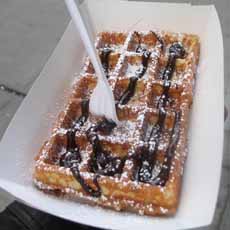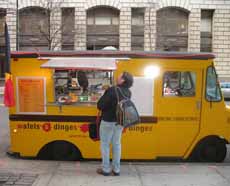Wafels & Dinges Belgian Waffles
|
March 25th is International Waffle Day. Fortunately, we live in New York City, where it is easy to get authentic Brussels and Liège waffles*, thanks to Wafels & Dinges.
The company operates food trucks and kiosks. If you’re hesitant to take on the carbs, give yourself a treat: They’re worth it. In fact, the plain waffles are so good, we don’t even need any dinges (“things,” i.e., toppings, plus beverages). According to the company, in 2007, Albert II, then King of Belgium, mandated that the Belgian Ministry of Culinary Affairs bring authentic Liege and Brussels wafels to New York City. What passed as “Belgian waffles” in the U.S. needed a serious upgrade. Wafels & Dinges was born, and we thank King Albert. The dinges include bananas, dessert sauces (caramel, chocolate, speculoos/spekuloos), ice cream, maple syrup (a nod to American preferences), Nutella, pearl sugar, powdered sugar and whipped cream. Recently, the company introduced Tofu Boost waffles, using House Foods’ excellent tofu. You can’t taste the tofu, just a delicious, crisp waffle. But if you need an excuse, call it an excuse to eat protein. Locations of the Wafels and Dinges trucks vary, but you can call 866-429-7329 or check on Wafelsanddinges.com. They are hand-delivered in New York City and shipped everywhere. Take a look. Waffle Day began in Sweden, known as Våffeldagen. It was actually the result of pronunciation: “Our Lady’s Day,” Feast of the Annunciation, called Vårfrudagen in Swedish. Vårfrudagen, celebrated on March 25th, sounds very similar to Våffeldagen (Waffle Day) in vernacular Swedish [source]. No one wanted to give up an occasion to eat waffles, so the new holiday, Våffeldagen, was designated to mark the beginning of spring. A different Waffle Day was established in the U.S. on August 24th. It celebrates the anniversary of the patenting of the first waffle iron in the U.S. The two holidays are now known in the U.S., respectively, as International Waffle Day (March 25th) and National Waffle Day (August 24th). The earliest waffle irons originated in The Netherlands around the 14th century. The waffles were baked over the fire in the hearth. |
 [1] Brussels waffle with chocolate fudge sauce and powdered sugar (photo © BillyBoy | Forums.Roadfood.com).
|
|
|
The waffle irons were constructed of two hinged iron plates connected to two long wood handles (photo). Many were crafted to imprint design patterns on the waffle: coats of arms, religious symbols, landscapes, etc. (and finally, the honeycomb pattern of today’s waffle irons). In the 19th century, the design was adapted to be used atop the kitchen stove. In 1869, Cornelius Swartwout of Troy, New York patented a waffle iron for stove top use, consisting of cast-iron plates joined by a hinge that swiveled in a cast-iron collar (here are photos of it). In 1891 John Kleimbach, a German immigrant in Shamokin, Pennsylvania, created a waffle iron for the Mansion House Hotel and became a traveling salesman, spreading the joy of waffles [source]. Fast forward: In 1971, Oregon track coach Bill Bowerman used the family waffle iron to experiment with the idea of a new sole for track footwear that would grip but be lightweight. He became co-founder of Nike, which helped to revolutionize athletic shoes. ________________ *Brussels wafels/waffles are what America generally calls “Belgian waffles,” although Belgians don’t appreciate that nomenclature. Authentic Belgian waffles are not made with pancake batter, but with a yeast-leavened dough that produces a lighter, crisper texture. Liège wafels/waffles are made with pearl sugar, a beet sugar. The pearls burst and caramelize when the dough hits the waffle iron, resulting in a dense, sugary waffle. Liège waffles are Belgian street food; Belgians eat them plain, without toppings.
|
||




